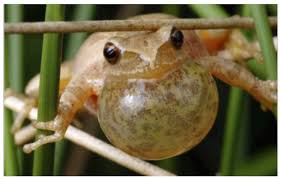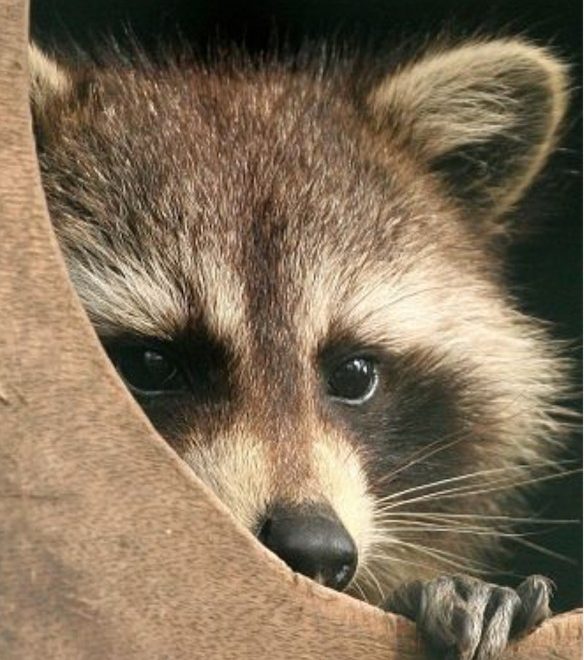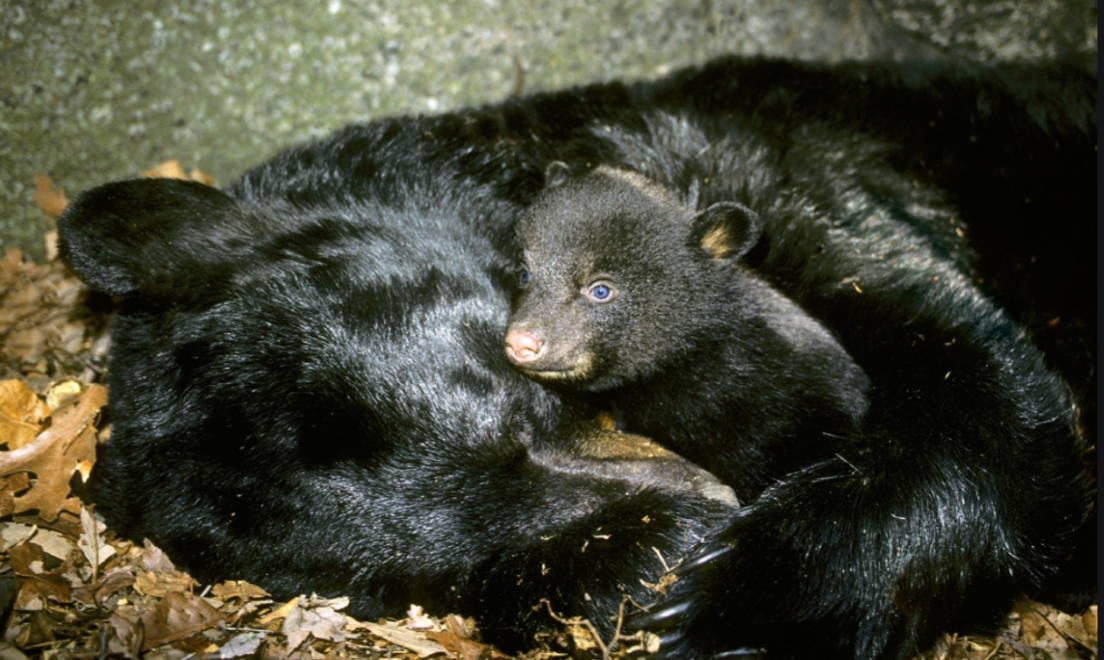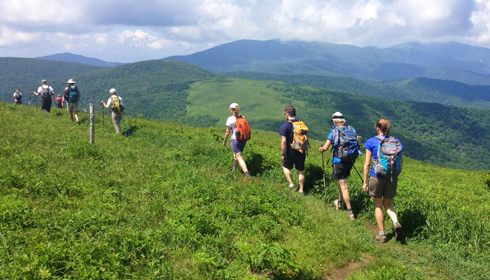Coyotes: Just Going Along
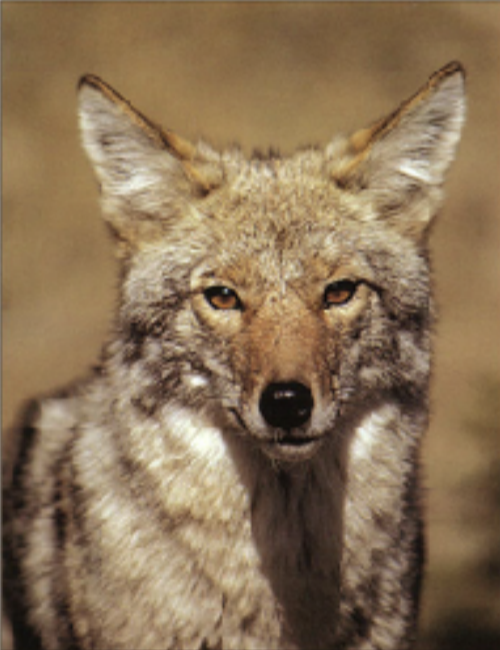
by Linda Martinson
February 2020
One could write a book about coyotes, but don’t bother because an excellent and engaging one has already been written: Coyote America by Dan Flores. Coyote America has been described as “one of the great epics of our time…a masterly synthesis of scientific research and personal observation….the illuminating five-million-year biography of [an] extraordinary animal.”
Coyotes — are you for them or against them? Apparently, you can tell by the way you pronounce the word: if you call them “ky-otes,” you are against them; if you call them “ky-o-tees”, you are for them. I am for them and so is Dan Flores, who considers the coyote the “essential North American mammal,” and its howl, “the original national anthem of North America.”
Flores also describes the coyote as North America’s oldest surviving deity, and he defines “coyote power” as “surviving by one’s intelligence and wits when others cannot; embracing existence in a mad, dancing, laughing, sympathetic expression of pure joy at evading the grimmest of fates; exulting in sheer aliveness; recognizing our shortcomings with rueful chagrin….” Coyote stories have existed from Paleolithic times (based on ancient cave art) to the present, perhaps because coyotes remind us of…well, ourselves.
In addition to trying to exterminate or to ‘manage’ coyotes, we have also made them cultural icons for example, the Coyote tales of American Indian storytellers; countless American folklore Coyote stories including a poetry journal called Coyote’s Journal; and even with Wile E. Coyote cartoons. Flores describes the Coyote/Old Man America icon as an avatar of both coyotes and humans and “very useful because he somehow manages to get a free pass to speak truth about humanity….and about America…. Old Man America has been going along, having many a wonderful adventure; showing us the contradictions of life; and starring in his own biography of immortality for many years.”
To pull you into this account of coyote facts and stories, consider the images, and videos of “coyote and badger friends” that have been circulating lately on the Internet.
The images and video were captured in early February 2020. The still photos taken in scientific studies, as well as Native American records, also demonstrate that the two predators do roam around and hunt together, probably for ground squirrels (see the photo below). The video was taken as part of a three-year study, with 50 remote-sensor cameras, being conducted in the southern part of the San Francisco Bay area by Peninsula Open Space Trust (POST). This video is unique because it shows two very different animal species, both predators and both often persecuted by humans, obviously at ease with each other with no aggressive behavior and presumably, off on an adventure together.
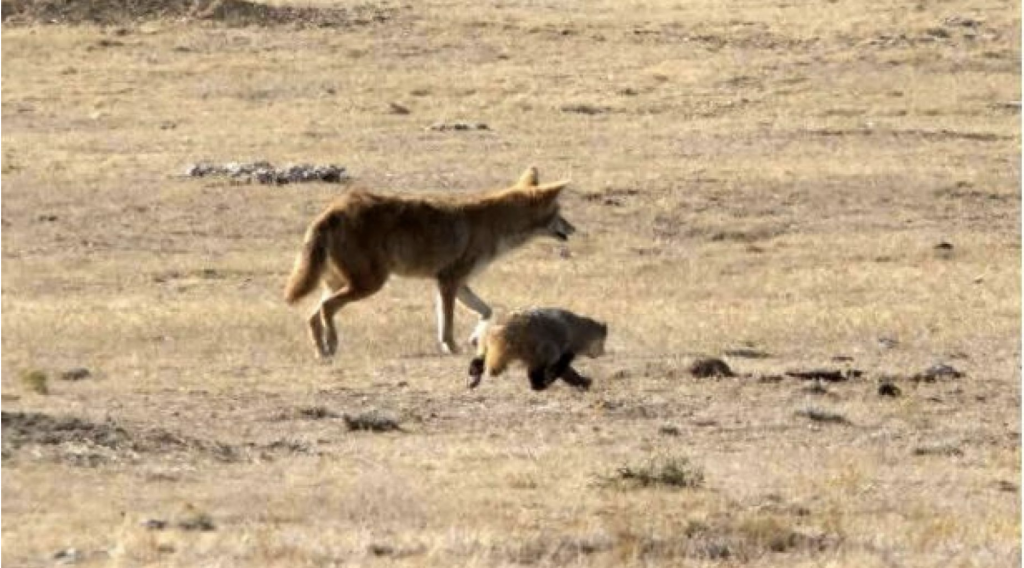
Despite centuries of humans trying to kill them all using guns, gases, helicopters, poison and engineered epidemics, coyotes have not only survived, they have thrived and spread all over the North American continent from Alaska to New York City. It took a while, but coyotes have now moved into every major city in the U.S., including Los Angeles, Chicago, Houston, Atlanta and New York City, and in numerous small towns. Many studies indicate that coyote populations in the United States are at an all-time high.
There is some speculation that these successful coyote moves into cities and small towns coincided with the introduction of leash laws and other restrictions against having dogs-at-large, mostly during the mid-to-late 1900s when contracting rabies from dog bites was a major concern. There are good reasons to restrict dogs. According to a recent study (2019) conducted by the Centers For Disease Control and Prevention, approximately 4.7 million dog bites occur in the United States each year, and 800,000 of those bites result in medical care. The U.S. population is approximately 325.7 million people as of 2017. That means a dog bites approximately 1 out of every 69 people annually. Dogs are adapted to living with us, and often bred to protect us, coyotes have adapted to living near humans for thousands of years and they just want to get along, they don’t want to live with us.
I saw my first coyote in Atlanta sometime in the early to mid-90s. My friends and I used to walk with our dogs early in the morning in a park before work. Occasionally, we saw coyotes, but our dogs never noticed them. The coyotes were just going along and when they saw us, they shot a conspiratorial glance at us and just faded away before the dogs noticed them. One special morning when I was driving to meet friends for a park walk, I saw two coyotes cavorting, almost dancing, in the moonlight at a golf course sufficient unto themselves and obviously having a super fun time together.
Since we moved to Western North Carolina, I rarely see coyotes but I hear them all the time and it’s obvious that they are living comfortably among us in our small rural community. Coyotes prefer to live near humans, because they are cosmopolitan just as we are. They may snatch the occasional small pet, usually an outdoor cat, but their main food sources are rats and mice and other small mammals that live near human developments. They will eat whatever they can find, however, insects, fruit, fish, frogs, carrion, garbage and even plants. They get along well living in close vicinity with us—there are very few accounts (single digits) of attacks on humans —most encounters with humans and their dogs involve an insouciant coyote just going along and making eye contact with a quick sidelong look, just as I saw with my friends walking with our dogs.
The coyote (Canis latrans) is a canine native to North America. They are about the size of a skinny border collie, around 32 to 37 inches long not including their tail (12 – 16 inches) that they typically carry much lower than dogs do. Adult coyotes typically weigh about 20 to 50 pounds and they generally live from 6-8 years but can live up to 14 years. They are quick and agile, able to run about 40 mph, and they can cover ground, too, not uncommonly 5-10 miles a day. Coyotes are smaller than their close relative, the gray wolf, and slightly smaller than the also closely related eastern wolf and red wolf. Coyotes are also smaller than their howls indicate and so are their pack sizes.
Coyotes are monogamous and form strong family groups generally with litters of three to twelve pups born every spring. And apparently the coyotes now living in cities are exceptionally loyal to each other and committed to raising their litters together. Scientists at The Ohio State University genetically sampled 236 coyotes in the Chicago area over a six-year period and found no evidence of polygamy nor of one coyote mate ever leaving another while the other was still alive. Coyotes in cities and other areas with high population densities have plenty of food to eat, a condition that leads other canines, some fox species for example, to stray from their typical monogamy. The researchers, however found that these city coyotes demonstrated incredible loyalty to their partners which could be a key to their success in busy urban areas. One researcher explained that a single female coyote would likely be unable to raise a large litter of pups by herself and to train them to survive in a large bustling city, but “the male coyotes in Chicago spend just as much time raising and training those pups as the female does.”
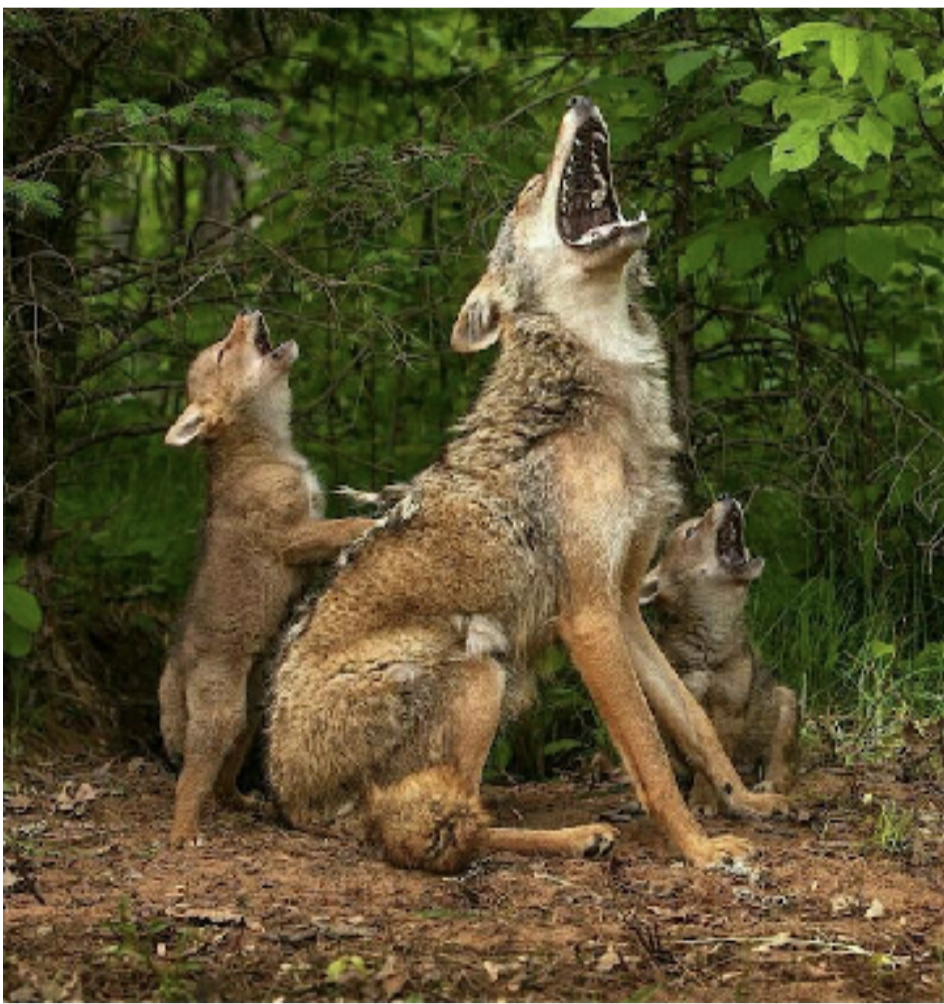
Coyotes moved in a northern route from the prairies and grasslands into the upper midwest United States in the late 1800s, and from there into Canada in the early 1900s and down through the other northeastern states to West Virginia by the mid-1970s. Migrating coyotes then took a second path across the Mississippi River from the western states to the southeastern states. They moved into Arkansas by the 1920s, and by the late-1980s, coyotes had moved into all the southeastern states arriving in Georgia, Florida, Kentucky, Maryland, North Carolina and South Carolina by the mid-to late-1980s (Moore and Parker 1992, Mastro 2011).
There are coyotes in all 100 counties in North Carolina, and they are thriving here. There is a cultural myth in North Carolina, that I’ve heard repeated with conviction here in Transylvania County, that the North Carolina Wildlife Resources Commission deliberately released coyotes into the state. This is not true; our coyote neighbors in North Carolina did not need any help moving in! Prior to 1990, there were only occasional reports of coyotes in North Carolina mainly on the coast and those coyotes were probably captured in the Western US and then released there for hunting. There is open hunting for coyotes in every NC county which doesn’t seem to affect their numbers at all. Coyotes may prefer to live in natural undeveloped areas, but they have easily adapted to golf courses, city parks, cemeteries and to forested areas bisected by highways. They adapt quickly — they will eat almost anything and they quickly change their habits to suit their environment. For example, city coyotes are most active at night, but in rural areas they are most active at dawn and dusk.
Coyotes are just going along fitting in everywhere in North America. Here is photo of a coyote who was exploring the rail system at the Portland International Airport one night in 2002. He hopped into a train and curled up on a seat apparently waiting for a ride into the city. When he was lassoed and hauled off the train, he just as casually bounded away into the fields around the airport.
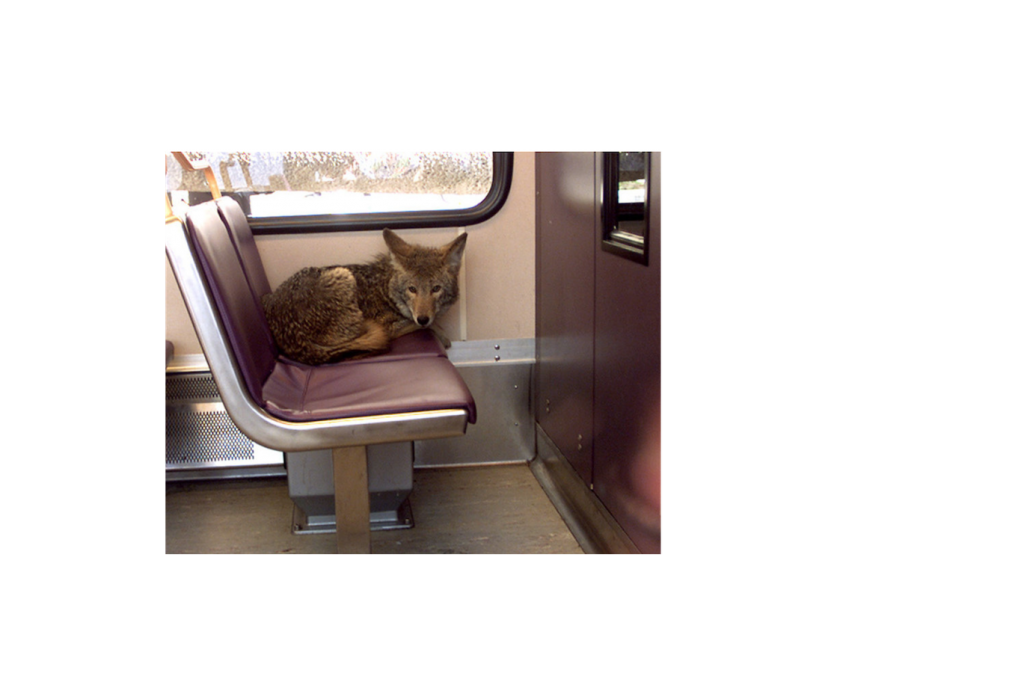
What kind of an animal are coyotes anyway? One answer is a despicable predator and another is an unfairly persecuted animal, and the answer depends on who you are and where you live. Coyotes were originally animals of the western plains, but they began to gradually move east when Americans began ranching and herding in the western plains. The main reason coyotes moved along is that once ranchers began developing domestic herds of animals, almost collectively they began working to annihilate coyotes with open hunting, even from helicopters, trapping, and with poisons. Even though some research indicates that most coyotes generally don’t prey on domestic range animals, Wildlife Services, a little-known program run by the U.S. Department of Agriculture, still works to kill coyotes indiscriminately with these costly methods. For example, in 2018, the agency killed more than 68,000 coyotes in the U.S., 5,600 just in Wyoming.
One problem is that some coyotes do kill domestic range animals, and they are quite efficient, but it is challenging to identify which individual coyotes do most of the killing. The second problem is that when a concerted effort is made eradicate coyotes, they in turn make a concerted effort to to breed more often and to double, even triple, the size of their litters. For example, in two removal areas in Wyoming during 1987-1988, the coyote population was reduced from 44-61% and 51-75% respectively. Within 8 months, however, both pack size and density of coyotes in both areas rebounded to pre-removal levels and the size of their home range did not change. Also, the litter size of the coyotes in these areas significantly increased within two years.
Coyotes are constantly on the move, especially during the fall and winter, defining and defending territory boundaries; exploring possible new denning opportunities; and/or searching for potential mates. These dispersal rates, especially with young coyotes, can be high and they can move easily into new and sometimes distant territory. Wildlife management records in North Carolina show that some coyotes in North Carolina have dispersed more than 200 miles in just a few months. This indicates why efforts to eradicate coyotes from an area are usually unsuccessful; as soon as problem coyotes are removed, new coyotes move in to fill the empty space.
Apparently, targeted control of the coyotes that have become habituated to killing livestock can work if the offending coyotes can be identified accurately, but population control of coyotes in general is difficult in the long run. In a study done in 2009, An Economic Analysis of Predator Management in Wyoming, commissioned by the Wyoming Animal Damage Board and the Wyoming Department of Agriculture, the authors stated;
“Our research shows that although predator control has a long history in Wyoming, it is very difficult to develop a complete picture of its economic contribution….Much data has been collected on the number of livestock killed by predators…but very little on the effectiveness of management procedures. Only broad estimates exist on the number of predators, their densities and how they relate to their prey species…(so) it is difficult to say what the affects of predation would be without predator management. This is important because it implies that we do not have much to measure against and that makes judging the relative economic benefits of predator management all the more difficult.”
This conclusion indicates that perhaps millions of dollars are being spent on a problem that is neither completely understood nor well defined. It wouldn’t be the first time in the incredible story of coyote survival. As Flores states in Coyote America, “In the war between humans and coyotes, coyotes have won hands-down.”
What is the coyote backstory? How did they become the smartest, most genetically adaptive, flexible and resilient mammal of North American wildlife and so devoted to their mates and to training their pups? How have they survived and thrived for thousands of years despite being persistently hunted? And why are there so many coyote stories and almost a “religion” of universal Coyote Man avatar tales beginning in ancient North America?
The coyote backstory begins in the Pleistocene epoch which roughly coincided with the Paleolithic time span during which humans began making tools. The Pleistocene epoch began about 2.6 million years ago and lasted until about 11,700 years ago, and it was characterized by repeated glacial cycles. It was also characterized by epic expansions and extinctions. Since most of the water on Earth was ice at that time, rainfall during most of the epoch was about half what it is today and the average global temperatures were about 9 to 18 degrees Fahrenheit below our current temperatures. Although there were seasons during that period, the snow never completely melted even in the summers.
A quarter of a million years ago, the gigantic dire wolf (Canis dirus) emerged as a species on the Great Plains of North America joining American wolves and early coyotes, which were also relatively large. This followed a time when megafauna, mostly huge grazing animals, like mastodons and long-horned bison, migrated out of Siberia across the Bering land bridge. They joined the herds of native horses and camels and tigers and lions on our continent during a time when bison and elk were just medium-sized grazers and the native coyotes were wolf-sized with large heavy heads and fierce teeth.
Early homo sapiens apparently were at least somewhat successful for thousands of years in this world with a harsh changing climate and giant animals, and so were the large coyotes and wolves, but then a major extinction of megafauna began late in the Pleistocene epoch. About 13,000 years ago, more then 75% of the large animals of the Pleistocene Ice Age died out; due to their greater habitat requirements and lower reproductive rates they were more vulnerable to extinction. Altogether, 32 genera of truly dramatic large animals were lost from the North American continent.
With the final extinction of most of the large grazing animals, the amazing adaptive biological flexibility of the coyote emerged. Both the wolves and the coyotes were large and successful predators during the Pleistocene, when there were immense herds of large grazers, but these canine species changed after the extinctions of about 13,000 years ago. The dire wolf with its large fearsome teeth became extinct, but the gray wolf survived and stayed about the same size — they were approximately 5 to 6 feet long and weighed from 80 to 120 pounds—and they remained pack animals. Coyotes, however, changed significantly — they shrunk! They were about the same size as gray wolves during the Pleistocene epoch but after the final extinctions of the epoch, coyotes shrunk to about 25 to 45 pounds and 3 to 4 feet long with smaller lean heads. They also shifted to hunting small game and became scavengers and omnivores and they also evolved with both strong jaws and canine teeth and also with molars so they could also grind and chew plant foods.
The evolution of coyotes after the extinctions of the Pleistocene also resulted in a rare, unique and highly successful adaptation which they generally share only with humans. Canids species and humans are both intensely social, but coyotes alone among canids and other species, too, developed a unique social life described in both anthropological and zoological terms as “fission-fusion.” It means that both humans and coyotes are intensely social but with a unique kind of flexible sociality. They are opportunists that can thrive in completely new situations. Individual humans and coyotes are flexible; they can be either gregarious or solitary depending on their situation and the environmental conditions. Coyotes can either cooperate with other members of their species, usually a pack of closely related individuals, or go it alone as solitary hunters or as a pair hunting together.
Coyotes have other fortunate evolutionary traits that help explain their resilience and adaptability. One trait is the sharing of learned behavior. Both human children and coyote puppies have relatively lengthy childhoods during which both of their parents or long-term mates assist in rearing them and in imparting cultural skills and critical information to them about their world.
Another critically important coyote adaptation is that they have an autogenic trait that allows them to assess the ecological possibilities around them. Apparently one important function of the coyote’s yipping howls is to assess the size of the surrounding coyote population. If they are not threatened within a breeding area, coyotes will fill their territory to carrying capacity and then have small litters with only a few pups. However, if they are persecuted and their population drops below carrying capacity, they will both breed more frequently and have significantly larger litters and allow transient coyotes to move into their territory. Also, if an alpha female coyote is killed, a “teen-aged” female coyote can come into estrus quickly and mate with the surviving male to have a replacement litter of pups.
Coyotes also have a remarkable evolutionary skill set. One example is that coyotes have 1,000 times more scent receptors than humans and there is some evidence that coyotes “read” scent markers better than dogs. This is probably because as wild animals, they gather more relevant information from scent markings than pet dogs do. Coyotes also have exceptionally keen hearing extending into a range about 25 percent higher than dogs. Coyotes also can see as well as humans and their peripheral vision is much better.
Finally, coyotes have superior observational learning intelligence well above that of other animals. In Coyote America, Flores speculates that because coyotes evolved for 20,000 years alongside wolves, coyotes evolved as animals that were naturally wary, even nervous. Because they were often prey as well as predators, coyotes are careful and circumspect to the “point of extreme wariness.” Flores quotes a Yellowstone biologist: “…when, like the coyote, you’ve been persecuted your entire existence, you learn how to be clever.” And you learn to be suspicious of new developments, objects, and smells in your habitat as well as learning extremely quickly from experience. Again, all these traits sound almost human!
In conclusion, Flores reminds us that coyotes have persisted and thrived for thousands of years and survived both epic climate challenges and persistent persecution. And therefore, as we humans face what may be daunting environmental and ecological challenges, we would do well to watch coyotes closely to see how their behavior shifts so we humans can continue to enjoy the 500,000 year-old coyote serenade to the universe.
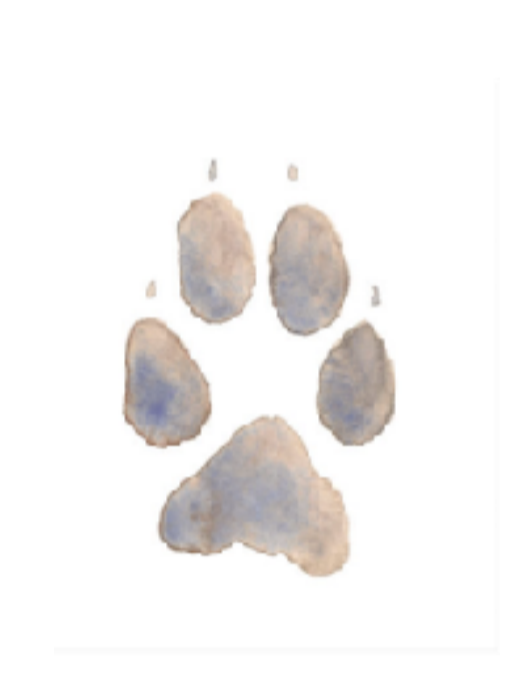

References:
Forest, Dan. Coyote America: a Natural and Supernatural History. New York: Basic Books, 2016
Knebusch, Kurt. “Urban Coyotes Never Stray: Study Finds 100% Monogamy.” September 26, 2012. cafes.osu.edu
Mastro, Lauren L., “Life History and Ecology of Coyotes in the Mid-Atlantic States: A Summary of the
Scientific Literature” (2011). USDA National Wildlife Research Center, 1336.
Taylor, D. T. An Economic Analysis of Predator Management in Wyoming. Wyoming Animal Damage Board and the Wyoming Department of Agriculture. January 2009.
“Why Coyotes are Thriving in North Carolina. February 23, 2018. science.unctv.org
Wild Animals/Rabies in U.S. June 2019 cdc.gov

